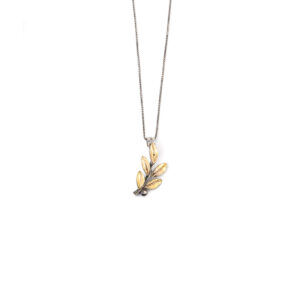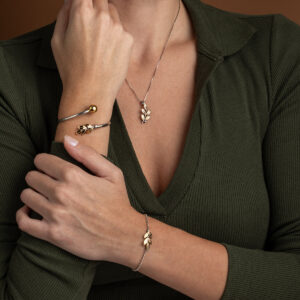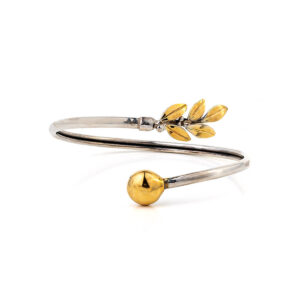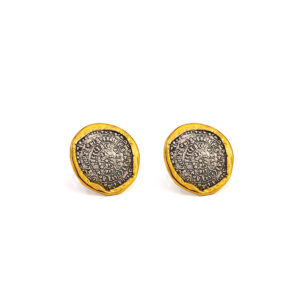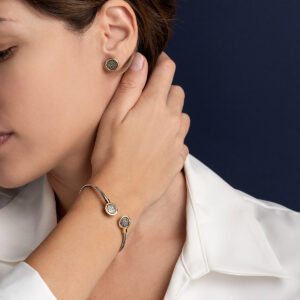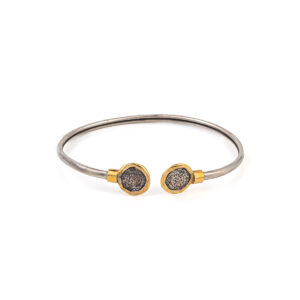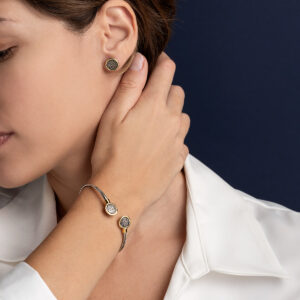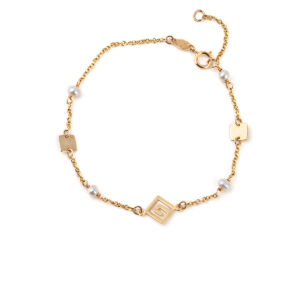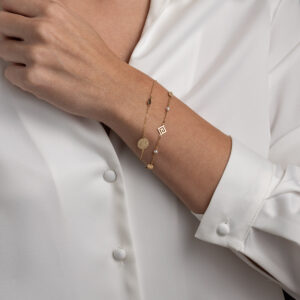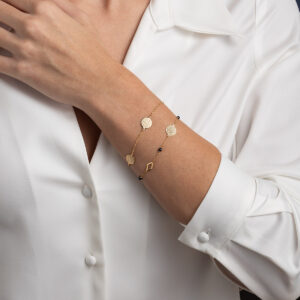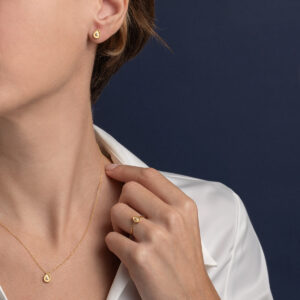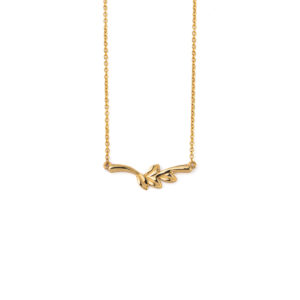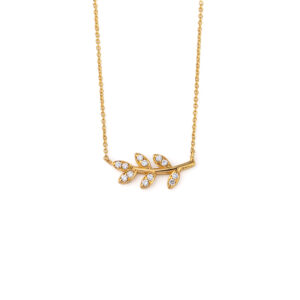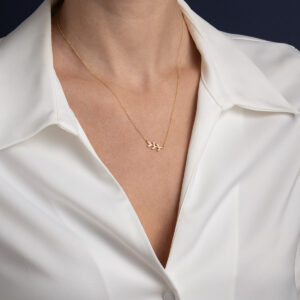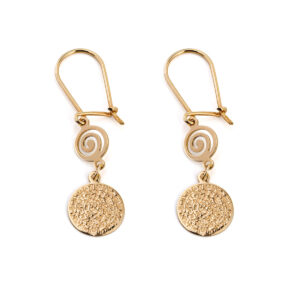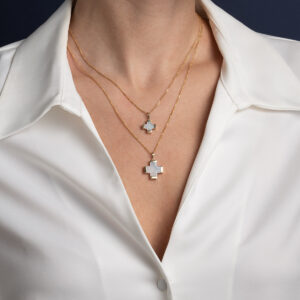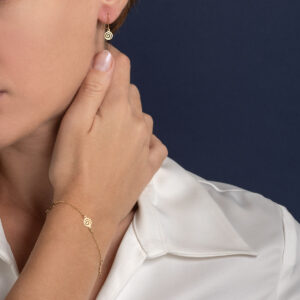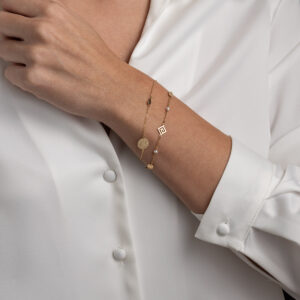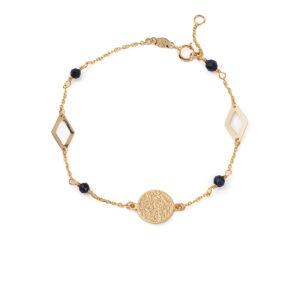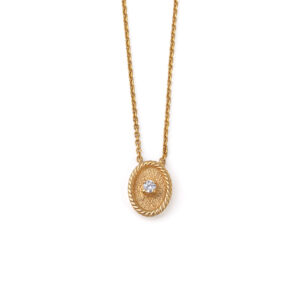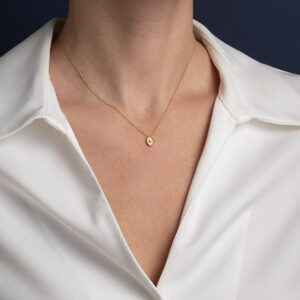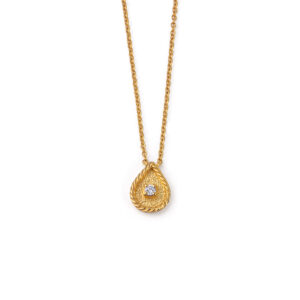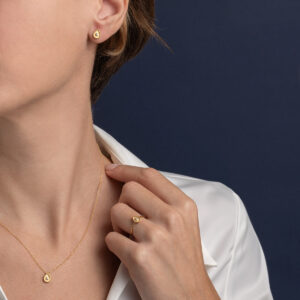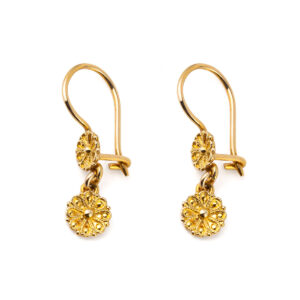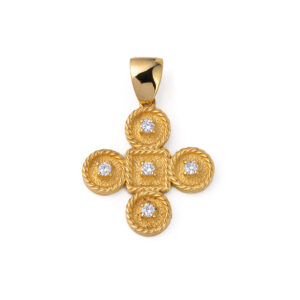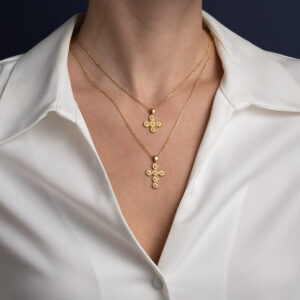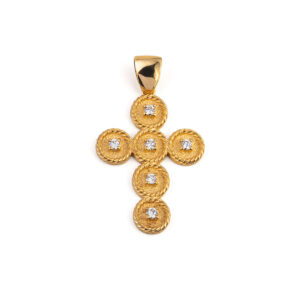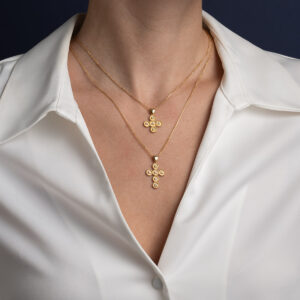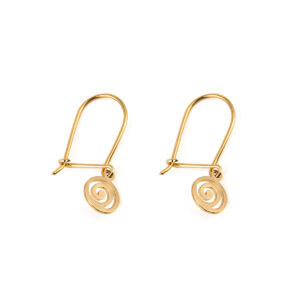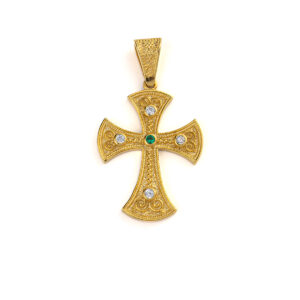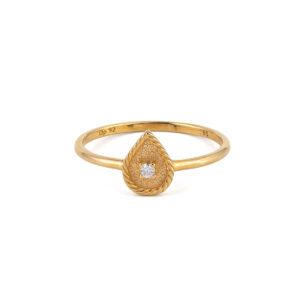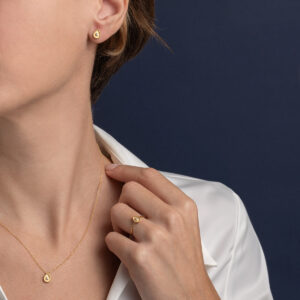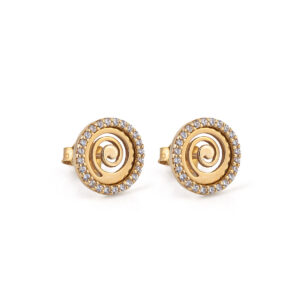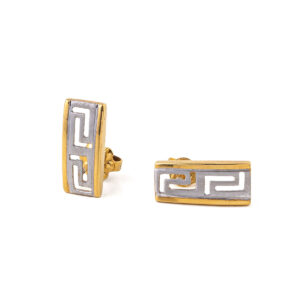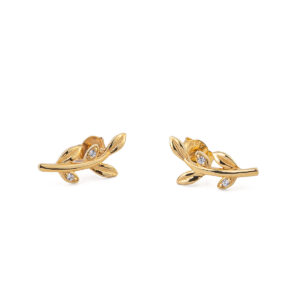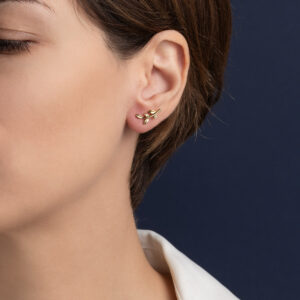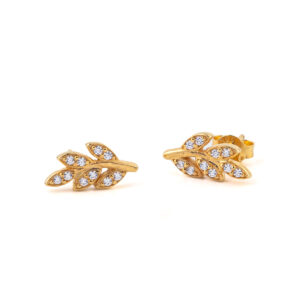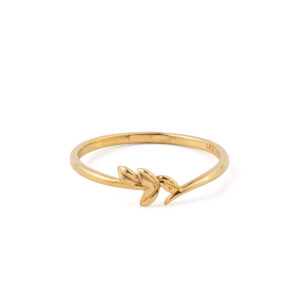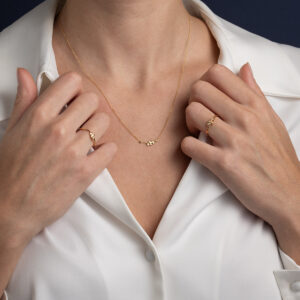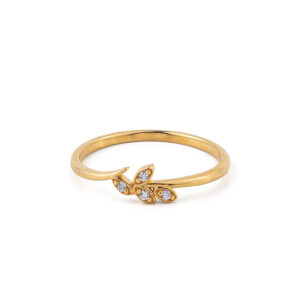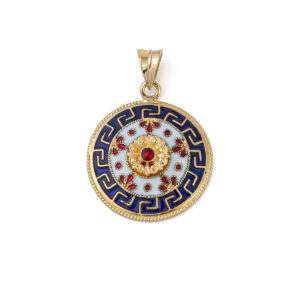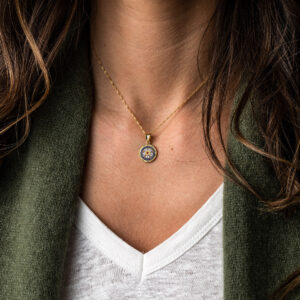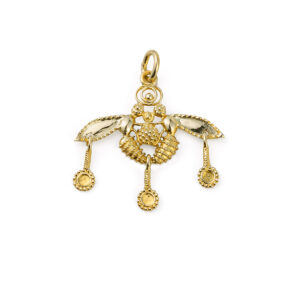Olive Leaf Chain Necklace – 14K Gold and Sterling Silver
Made of sterling silver 925° and 14k gold.
Handmade in Greece.
Explore Olive Collection
The olive wreath known as kotinos was the prize for the winner at the ancient Olympic Games. It was an olive branch, of the wild- olive tree that grew at Olympia, intertwined to form a circle or a horse-shoe. According to Pausanias, it was introduced by Heracles as a prize for the running race winner to honor his father Zeus. In the ancient Olympic Games there were no gold, silver, or bronze medals. There was only one winner per event, crowned with an olive wreath made of wild olive leaves from a sacred tree near the temple of Zeus at Olympia. Olive wreaths were given out during the 2004 Summer Olympics in Athens in honor of the ancient tradition because the games were being held in Greece.
Olive Leaf Chain Bracelet – 14K Gold and Sterling Silver
Made of sterling silver 925° and 14k gold.
The bracelet is bendable.
Handmade in Greece.
Explore Olive Collection
The olive wreath known as kotinos was the prize for the winner at the ancient Olympic Games. It was an olive branch, of the wild- olive tree that grew at Olympia, intertwined to form a circle or a horse-shoe. According to Pausanias, it was introduced by Heracles as a prize for the running race winner to honor his father Zeus. In the ancient Olympic Games there were no gold, silver, or bronze medals. There was only one winner per event, crowned with an olive wreath made of wild olive leaves from a sacred tree near the temple of Zeus at Olympia. Olive wreaths were given out during the 2004 Summer Olympics in Athens in honor of the ancient tradition because the games were being held in Greece.
Olive Leaf Bangle Bracelet – 14K Gold and Sterling Silver
Made of sterling silver 925° and 14k gold.
The bracelet is bendable.
Handmade in Greece.
Explore Olive Collection
The olive wreath known as kotinos was the prize for the winner at the ancient Olympic Games. It was an olive branch, of the wild- olive tree that grew at Olympia, intertwined to form a circle or a horse-shoe. According to Pausanias, it was introduced by Heracles as a prize for the running race winner to honor his father Zeus. In the ancient Olympic Games there were no gold, silver, or bronze medals. There was only one winner per event, crowned with an olive wreath made of wild olive leaves from a sacred tree near the temple of Zeus at Olympia. Olive wreaths were given out during the 2004 Summer Olympics in Athens in honor of the ancient tradition because the games were being held in Greece.
Phaistos Disc Earrings – 925 Sterling Silver and 14K Gold
A pair of earrings inspired by the ancient disk found in Phaistos.
Made of 925⁰ sterling silver and 14k gold.
Handmade in Greece.
Explore Phaistos Disc Collection
History
The Phaistos Disc is a disk of fired clay from the Minoan palace of Phaistos on the island of Crete. Now, the island of Crete is part of modern Greece. The disc was discovered in 1908 by the Italian archaeologist Luigi Pernier in the Minoan palace site of Phaistos. While it is not clear that it is a script, most attempted decipherments assume that it is; most additionally assume a syllabary, others an alphabet or logography or a calendar.
Phaistos Disc Bangle Bracelet – 925 Sterling Silver and 14K Gold
A bracelet inspired by the ancient disk found in Phaistos.
Made of 925⁰ sterling silver and 14k gold.
Handmade in Greece.
Explore Phaistos Disc Collection
History
The Phaistos Disc is a disk of fired clay from the Minoan palace of Phaistos on the island of Crete. Now, the island of Crete is part of modern Greece. The disc was discovered in 1908 by the Italian archaeologist Luigi Pernier in the Minoan palace site of Phaistos. While it is not clear that it is a script, most attempted decipherments assume that it is; most additionally assume a syllabary, others an alphabet or logography or a calendar.
Meander Gold Chain Bracelet
270,00€Made of 14K gold.
Handmade in Greece
Explore Meandros Collection
Meandros design is a decorative border constructed from a continuous line, shaped into a repeated motif. Such a design is also called the Greek fret or Greek key design, although these are modern designations. On the one hand, the name “meander” recalls the twisting and turning path of the Meander River in Asia Minor, and on the other hand, as Karl Kerenyi pointed out, “the meander is the figure of a labyrinth in linear form” the meaning is that there is no beginning and no end in some cases so it becomes the symbol of long life and eternity.
Phaistos Disc Gold Bracelet
410,00€A bracelet inspired by the ancient disk found in Phaistos.
Made of 14k gold.
Handmade in Greece.
Explore Phaistos Disc Collection
History
The Phaistos Disc is a disk of fired clay from the Minoan palace of Phaistos on the island of Crete. Now, the island of Crete is part of modern Greece. The disc was discovered in 1908 by the Italian archaeologist Luigi Pernier in the Minoan palace-site of Phaistos. While it is not clear that it is a script, most attempted decipherments assume that it is; most additionally assume a syllabary, others an alphabet or logography or a calendar.
Teardrop Stud Earrings with Zircon – 14K Solid Yellow Gold
375,00€Made of 14k gold.
Handmade in Greece
Explore Crystal Collection
The collection contains jewelry with beautiful zircon stones.
Olive Leaf Necklace – 9K Solid Yellow Gold
190,00€Necklace inspired by the olive leaf symbol.
Made of 9k gold.
The olive wreath also known as kotinos was the prize for the winner at the ancient Olympic Games. It was an olive branch, of the wild- olive tree that grew at Olympia, intertwined to form a circle or a horse-shoe. According to Pausanias, it was introduced by Heracles as a prize for the running race winner to honor his father Zeus. In the ancient Olympic Games, there were no gold, silver, or bronze medals. There was only one winner per event, crowned with an olive wreath made of wild olive leaves from a sacred tree near the temple of Zeus at Olympia. Olive wreaths were given out during the 2004 Summer Olympics in Athens in honor of the ancient tradition because the games were being held in Greece.
Handmade item.
Explore Olive Collection
Olive Leaf Necklace with Zircon – 18K Solid Yellow Gold
745,00€Necklace inspired by the olive leaf symbol.
Made of 18k gold with zircon.
The olive wreath also known as kotinos was the prize for the winner at the ancient Olympic Games. It was an olive branch, of the wild- olive tree that grew at Olympia, intertwined to form a circle or a horse-shoe. According to Pausanias it was introduced by Heracles as a prize for the running race winner to honour his father Zeus. In the ancient Olympic Games there were no gold, silver, or bronze medals. There was only one winner per event, crowned with an olive wreath made of wild-olive leaves from a sacred tree near the temple of Zeus at Olympia. Olive wreaths were given out during the 2004 Summer Olympics in Athens in honor of the ancient tradition, because the games were being held in Greece.
Handmade item.
Explore Olive Collection
Spiral Phaistos Disc Dangle Earrings – 14K Solid Yellow Gold
340,00€Made of 14k gold.
Handmade in Greece.
Explore Spiral Collection
The spiral is one of the oldest symbols of human spirituality, carved or painted into rocks from thousands of years ago. Symbol of movement and progressive development, growth, expansion, cosmic energy, symbol of the sun..Spirals have been found in burial sites, in vases, in jewelry, clothing, weapons… They can be seen in every aspect of nature, like the tides in the oceans, the winds, the plants, the shells. The spiral phenomenon has been explained through mathematics from the time of Archimedes, the great Greek mathematician.
White Cross Pendant – 14K Gold
145,00€ – 170,00€Beautiful Cross Pendant made of 14K Solid Gold.
Handmade in Greece
Baptism crosses and baptism crucifixes are classic gifts for a child and their parents on the special occasion of a child’s baptism.
Explore Religious Collection
Spiral Gold Chain Bracelet
185,00€Made of 14K gold.
Handmade in Greece
Explore Spiral Collection
Bracelet inspired by the ancient spiral motif.
The spiral is one of the oldest symbols of human spirituality, carved or painted into rocks from thousands of years ago. Symbol of movement and progressive development, growth, expansion, cosmic energy, and a symbol of the sun.. Spirals have been found in burial sites, in vases, in jewelry, clothing, weapons… They can be seen in every aspect of nature, like the tides in the oceans, the winds, the plants, and the shells. The spiral phenomenon has been explained through mathematics from the time of Archimedes, the great Greek mathematician.
Phaistos Disc Gold Bracelet
245,00€A bracelet inspired by the ancient disk found in Phaistos.
Made of 14k gold.
Handmade in Greece.
Explore Phaistos Disc Collection
History
The Phaistos Disc is a disk of fired clay from the Minoan palace of Phaistos on the island of Crete. Now, the island of Crete is part of modern Greece. The disc was discovered in 1908 by the Italian archaeologist Luigi Pernier in the Minoan palace-site of Phaistos. While it is not clear that it is a script, most attempted decipherments assume that it is; most additionally assume a syllabary, others an alphabet or logography or a calendar.
Phaistos Disc Bracelet – 14K Gold
315,00€A bracelet inspired by the ancient disk found in Phaistos.
Made of 14k gold.
Handmade in Greece.
Explore Phaistos Disc Collection
History
The Phaistos Disc is a disk of fired clay from the Minoan palace of Phaistos on the island of Crete. Now, the island of Crete is part of modern Greece. The disc was discovered in 1908 by the Italian archaeologist Luigi Pernier in the Minoan palace-site of Phaistos. While it is not clear that it is a script, most attempted decipherments assume that it is; most additionally assume a syllabary, others an alphabet or logography or a calendar.
Circle Zircon Necklace – 14K Solid Yellow Gold
310,00€Made of 14k gold.
Handmade in Greece
Explore Crystal Collection
The collection contains jewelry with beautiful zircon stones.
Teardrop Necklace with Zircon – 14K Solid Yellow Gold
330,00€Made of 14k gold.
Handmade in Greece
Explore Crystal Collection
The collection contains jewelry with beautiful zircon stones.
18K Gold Byzantine Rosette Earrings
465,00€Byzantine earrings with the shape of a flower rosette.
Handmade with great attention to detail. Inspired by Byzantine art.
Made in 18k gold.
Handmade item.
Explore Byzantine Collection
Rosette flower
The rosette (rose) is a timeless jewel, symbol, and amulet. The origin of the term is the Greek word for rose – rodon (ρόδον). Its use began in the Mycenaean era and continues as far as the 2nd millennium BC. The Mycenaean Rosette is a motif that was widespread throughout Mesopotamia, Egypt, Greece, and other ancient civilizations. It is inspired by a Mycenaean rosette bead, found at Mycenae, dated to 1400-1300 B.C. The rosette was used extensively in ancient Greek Mycenaean jewels, in architecture, pottery, and sculptures from 1500 BC. Mycenaean rosettes usually had 6 or 8 or 12 leaves, and sixteen leaves during the Macedonian Dynasty. Such details as the rodax shape and the number of leaves tend to vary with the era or beliefs. The rosettes were used to decorate the clothes, belts, and wreaths of the Kings. The number of leaves had a symbolic character each time. The four elements of nature (wind, earth, fire, water), the seven wonders of the ancient world or the twelve gods of ancient Greeks, and the world domination and radiance of the Kings of Macedonia. They were signs of beauty, purity, eugenics, worship, and power. Rosette or Rodax was probably the most popular and favorite decorative element in Mycenaean era, classical antiquity and Byzantine times.
14K Gold Zircon Cross
745,00€Beautiful Cross Pendant made of 14K Solid Gold.
Handmade in Greece
Baptism crosses and baptism crucifixes are classic gifts for a child and their parents on the special occasion of a child’s baptism.
Explore Religious Collection
14K Gold Cross with Zircon
870,00€Beautiful Cross Pendant made of 14K Solid Gold.
Handmade in Greece
Baptism crosses and baptism crucifixes are classic gifts for a child and their parents on the special occasion of a child’s baptism.
Explore Religious Collection
Spiral Dangle Earrings – 14K Solid Yellow Gold
180,00€Made of 14k gold.
Handmade in Greece.
Explore Spiral Collection
The spiral is one of the oldest symbols of human spirituality, carved or painted into rocks from thousands of years ago. Symbol of movement and progressive development, growth, expansion, cosmic energy, symbol of the sun..Spirals have been found in burial sites, in vases, in jewelry, clothing, weapons… They can be seen in every aspect of nature, like the tides in the oceans, the winds, the plants, the shells. The spiral phenomenon has been explained through mathematics from the time of Archimedes, the great Greek mathematician.
14K Gold Byzantine Cross with Zircon
535,00€Beautiful Cross Pendant made of 14K Solid Gold.
Handmade in Greece
Baptism crosses and baptism crucifixes are classic gifts for a child and their parents on the special occasion of a child’s baptism.
Explore Religious Collection
Teardrop Ring with Zircon – 14K Solid Yellow Gold
330,00€Made of 14k gold.
Handmade in Greece
Explore Crystal Collection
The collection contains jewelry with beautiful zircon stones.
Spiral Stud Earrings – 14K Solid Yellow Gold
445,00€Made of 14k gold with zircon.
Handmade in Greece.
Explore Spiral Collection
The spiral is one of the oldest symbols of human spirituality, carved or painted into rocks from thousands of years ago. Symbol of movement and progressive development, growth, expansion, cosmic energy, symbol of the sun. Spirals have been found in burial sites, in vases, in jewelry, clothing, weapons… They can be seen in every aspect of nature, like the tides in the oceans, the winds, the plants, the shells. The spiral phenomenon has been explained through mathematics from the time of Archimedes, the great Greek mathematician.
Greek Key Stud Earrings – 14K Yellow Gold
170,00€Made of 14K gold.
Handmade in Greece
Explore Meandros Collection
Meandros design is a decorative border constructed from a continuous line, shaped into a repeated motif. Such a design is also called the Greek fret or Greek key design, although these are modern designations. On the one hand, the name “meander” recalls the twisting and turning path of the Meander River in Asia Minor, and on the other hand, as Karl Kerenyi pointed out, “the meander is the figure of a labyrinth in linear form” the meaning is that there is no beginning and no end in some cases so it becomes the symbol of long life and eternity.
Meander Stud Earrings – 14K Solid Yellow Gold
380,00€Made of 14K gold.
Handmade in Greece
Explore Meandros Collection
Meandros design is a decorative border constructed from a continuous line, shaped into a repeated motif. Such a design is also called the Greek fret or Greek key design, although these are modern designations. On the one hand, the name “meander” recalls the twisting and turning path of the Meander River in Asia Minor, and on the other hand, as Karl Kerenyi pointed out, “the meander is the figure of a labyrinth in linear form” the meaning is that there is no beginning and no end in some cases so it becomes the symbol of long life and eternity.
Olive Leaf Earrings with Zircon – 9K Solid Yellow Gold
250,00€Earrings inspired by the olive leaf symbol.
Made of 9k gold with zircon.
The olive wreath also known as kotinos was the prize for the winner at the ancient Olympic Games. It was an olive branch, of the wild- olive tree that grew at Olympia, intertwined to form a circle or a horse-shoe. According to Pausanias it was introduced by Heracles as a prize for the running race winner to honour his father Zeus. In the ancient Olympic Games there were no gold, silver, or bronze medals. There was only one winner per event, crowned with an olive wreath made of wild-olive leaves from a sacred tree near the temple of Zeus at Olympia. Olive wreaths were given out during the 2004 Summer Olympics in Athens in honor of the ancient tradition, because the games were being held in Greece.
Handmade item.
Explore Olive Collection
Leaf Earrings with Zircon – 14K Yellow Gold
390,00€Earrings inspired by the olive leaf symbol.
Made of 14k gold with zircon.
The olive wreath also known as kotinos was the prize for the winner at the ancient Olympic Games. It was an olive branch, of the wild- olive tree that grew at Olympia, intertwined to form a circle or a horse-shoe. According to Pausanias it was introduced by Heracles as a prize for the running race winner to honour his father Zeus. In the ancient Olympic Games there were no gold, silver, or bronze medals. There was only one winner per event, crowned with an olive wreath made of wild-olive leaves from a sacred tree near the temple of Zeus at Olympia. Olive wreaths were given out during the 2004 Summer Olympics in Athens in honor of the ancient tradition, because the games were being held in Greece.
Handmade item.
Explore Olive Collection
Olive Leaf Ring – 14K Solid Yellow Gold
192,00€Ring inspired by the olive leaf symbol.
Made of 14k gold.
The olive wreath also known as kotinos was the prize for the winner at the ancient Olympic Games. It was an olive branch, of the wild- olive tree that grew at Olympia, intertwined to form a circle or a horse-shoe. According to Pausanias it was introduced by Heracles as a prize for the running race winner to honour his father Zeus. In the ancient Olympic Games there were no gold, silver, or bronze medals. There was only one winner per event, crowned with an olive wreath made of wild-olive leaves from a sacred tree near the temple of Zeus at Olympia. Olive wreaths were given out during the 2004 Summer Olympics in Athens in honor of the ancient tradition, because the games were being held in Greece.
Handmade item.
Explore Olive Collection
Olive Ring with Zircon – 14K Solid Yellow Gold
249,00€Ring inspired by the olive leaf symbol.
Made of 14k gold with zircon.
The olive wreath also known as kotinos was the prize for the winner at the ancient Olympic Games. It was an olive branch, of the wild- olive tree that grew at Olympia, intertwined to form a circle or a horse-shoe. According to Pausanias it was introduced by Heracles as a prize for the running race winner to honour his father Zeus. In the ancient Olympic Games there were no gold, silver, or bronze medals. There was only one winner per event, crowned with an olive wreath made of wild-olive leaves from a sacred tree near the temple of Zeus at Olympia. Olive wreaths were given out during the 2004 Summer Olympics in Athens in honor of the ancient tradition, because the games were being held in Greece.
Handmade item.
Explore Olive Collection
18k Solid Gold Greek Key Pendant with Blue enamel
1.275,00€Ancient Greek Round Pendant with blue enamel. The back side of the pendant has no decoration.
Design inspired by the incredible beauty of historical tradition.
Made in 18k yellow gold.
The chain shown is our 14K Gold Twisted Chain in Length 40cm (not included).
Handmade item.
Explore Byzantine Collection
Gold Bee Pendant in 14K Solid Yellow Gold
442,00€Inspired by the ancient Minoan Greek Malia bees pendant.
Made of 14K Gold.
Handmade item.
The chain shown is not included.
Explore Heritage Collection
The Minoan Bees Pendant, one of the most famous Minoan artworks, was discovered in the Old Palace cemetery at Chrysolakkos, outside the palace of Malia, the third largest and most significant known Minoan palace after Knossos and Phaistos. Chryssolakkos means the “Pit of gold” because of the many precious objects that were found there. The famous pendant dates back to the Bronze Age, (1800 BC) and it’s a stunning, very detailed representation of two bees or wasps storing away a drop of honey in their honeycomb. This pendant is one of the most famous exhibits in the wonderfully Heraklion archeological museum.

